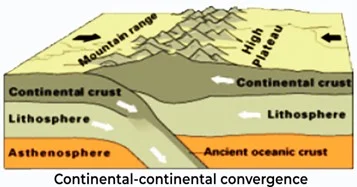Answer:
| Approach:
Introduction
- Brief about fold mountains.
Body
- Discuss factors association between fold mountains, earthquakes and volcanoes
Conclusion
- Conclude your answer with a summary of the answer.
|
Introduction:
Fold mountains are formed by the folding and uplift of rock layers due to tectonic plate movements. The collision of two continental plates, or the subduction of an oceanic plate beneath a continental plate, can create compressional forces that cause the Earth’s crust to buckle and fold, resulting in the formation of fold mountains.
Enroll now for UPSC Online Course
Body:
The world’s fold mountain systems are located along the margins of continents due to the following reasons:
- Plate Tectonics: Fold mountains are formed by the collision or convergence of tectonic plates. When continental plates collide, the intense compressional forces cause the crust to buckle, fold, and uplift, leading to the formation of mountain ranges along the plate boundaries. g Himalayas.
- Subduction Zones: Subduction zones, where one tectonic plate is forced beneath another, are common along continental margins. This process can result in the formation of volcanic arcs and accompanying fold mountains.
- Crustal Thickening: Along continental margins, the accumulation of sedimentary layers, coupled with the collision of plates, leads to the thickening of the continental crust. This thickened crust is less buoyant, causing it to rise and form fold mountains.g The Andes.
- Compression and Uplift: The compression and uplift of rock layers occur along the margins of continents due to the convergence of tectonic plates. These forces cause the crust to fold and uplift, creating mountainous topography.

- Association Between Fold Mountains and Earthquakes: Fold mountains are formed as a result of the collision of two tectonic plates. The movement and collision of these plates can cause earthquakes, as the plates grind against each other or one plate is forced beneath the other in a process known as subduction.
- Examples: The Himalayas are located at the boundary between the Indian Plate and the Eurasian Plate and are one of the most seismically active regions in the world.
- Association Between Fold Mountains and Volcanoes: Volcanoes are another common feature associated with fold mountains. As tectonic plates collide, one plate is often forced beneath the other, a process known as subduction. This can cause the mantle to melt, creating magma that rises to the surface and forms volcanoes. The Andes Mountains.
- Examples are located along the western coast of South America and are associated with the subduction of the Nazca Plate beneath the South American Plate. This subduction has led to the formation of a chain of volcanoes, including the active Cotopaxi and Tungurahua volcanoes in Ecuador.
Conclusion:
The concentration of fold mountain systems along the margins of continents can be attributed to plate tectonics, which is the theory that explains the movement of the Earth’s lithosphere. The interaction of tectonic plates can lead to the formation of mountain ranges, as well as earthquakes and volcanoes. The study of these natural phenomena is crucial for understanding the geologic processes that shape the Earth’s surface and for developing strategies to mitigate the potential hazards associated with earthquakes and volcanic eruptions.
